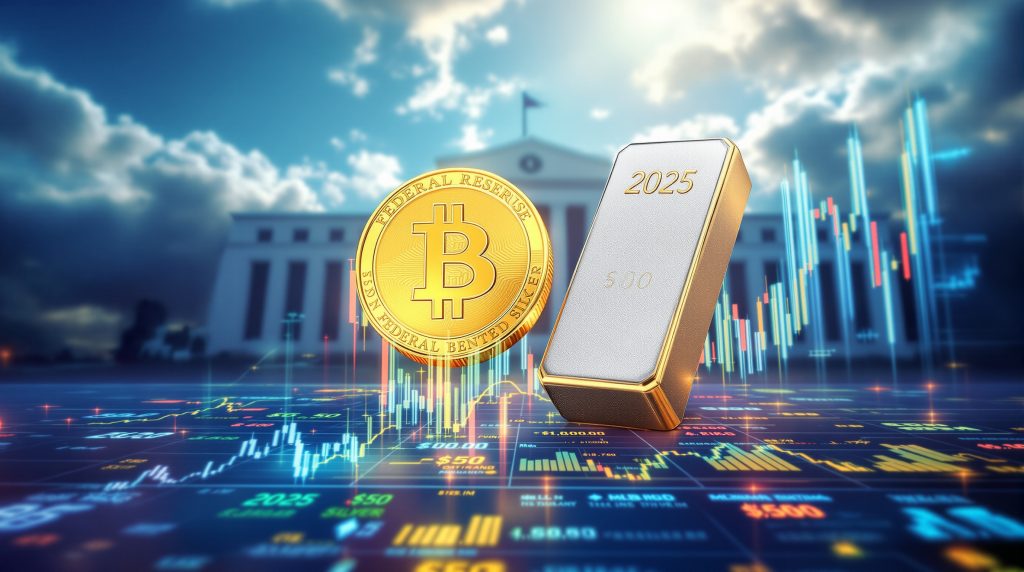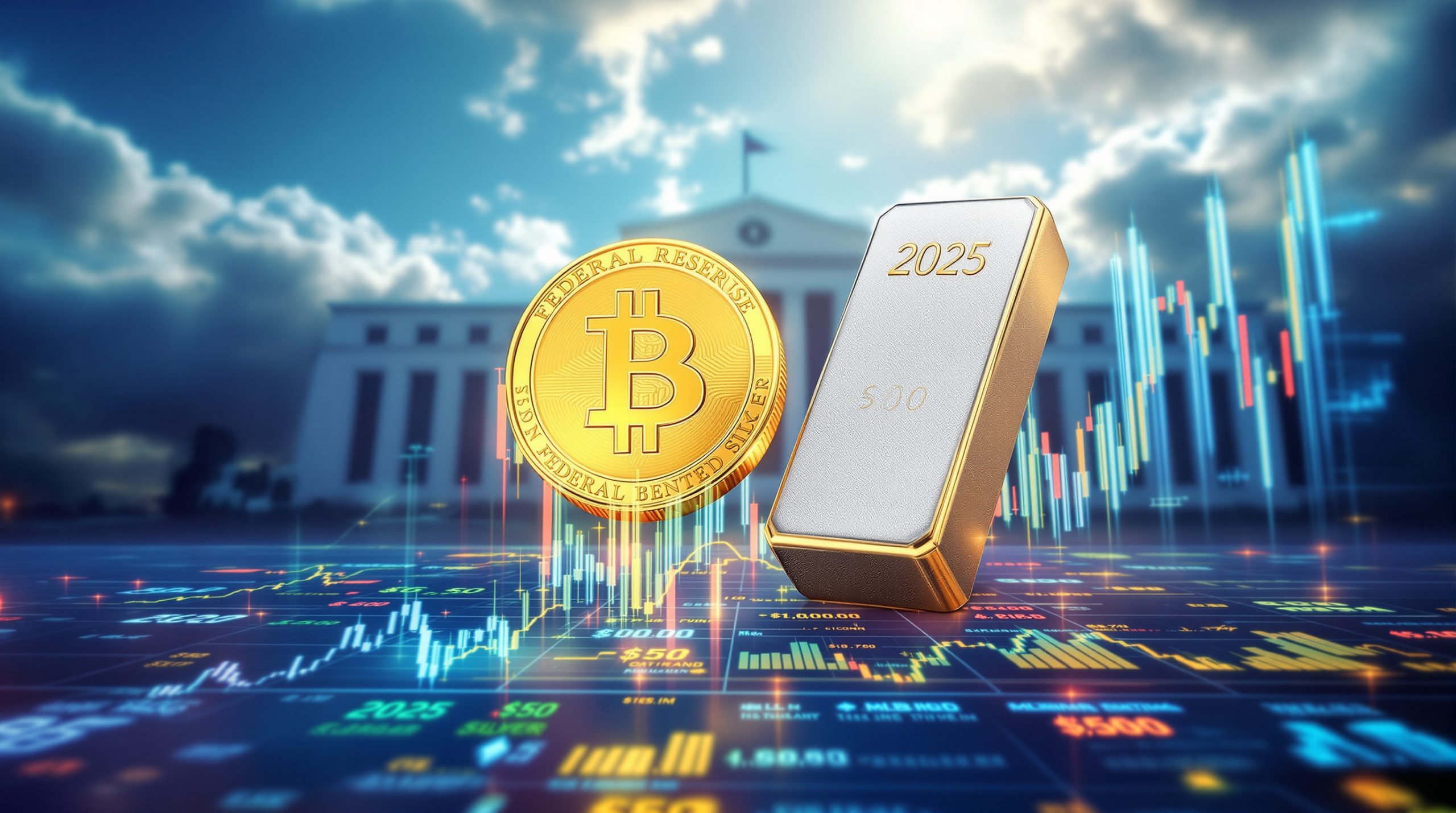Gold and Silver Market Trends in 2025: What's Driving the Precious Metals Rally?
The precious metals market has witnessed remarkable momentum in recent months, with gold recently touching new heights and silver approaching psychologically significant levels. This represents extraordinary growth, particularly for silver, which has surged approximately 66% year-to-date, with much of that growth concentrated in recent months.
These dramatic price movements have occurred against a backdrop of economic uncertainty, shifting monetary policy, and evolving investor sentiment. While mainstream financial media has been relatively quiet about this rally, particularly regarding silver, the market fundamentals suggest this could be more than a temporary spike.
What Economic Factors Are Driving Gold and Silver Prices Higher?
Monetary Policy Shifts and Liquidity Trends
The Federal Reserve's pivot toward monetary easing has significantly influenced precious metals markets. After maintaining elevated interest rates, the Fed's recent rate cuts have created a more favorable environment for non-yielding assets like gold and silver.
A critical but often overlooked factor is the M2 money supply, which continues to expand. Current data from the Federal Reserve Bank of St. Louis shows M2 growing at nearly 5% annually—the fastest pace in several years. This steady increase in money supply provides underlying support for precious metals, which traditionally serve as hedges against currency devaluation.
Market Anticipation of Future Policy Direction
Looking ahead, market participants are pricing in expectations of even more accommodative monetary policy. With leadership changes expected at the Federal Reserve, speculation about the approach to interest rates is influencing current market dynamics. The consensus view anticipates that future leadership will likely favor lower interest rates, which would typically support higher precious metals prices.
According to recent Federal Reserve communications, while immediate policy remains data-dependent, the longer-term trajectory suggests continued easing if economic indicators warrant such action.
Divergence Between Economic Reality and Financial Markets
A puzzling aspect of the current environment is the growing disconnect between real economic conditions and financial market performance. While job growth has slowed considerably—with recent private estimates showing minimal gains according to data from the Bureau of Labor Statistics—asset prices across multiple classes continue to climb.
This divergence creates a scenario where investors increasingly turn to markets rather than traditional economic indicators to guide their decisions, potentially creating a self-reinforcing cycle that benefits precious metals as both investment vehicles and safe-haven assets.
Why Is Silver Outperforming Gold in the Current Rally?
Silver's Dramatic Price Movement
Silver's performance has been particularly noteworthy, with prices climbing dramatically within the year—a substantial increase that outpaces many other asset classes. The most dramatic phase of this rally began in summer, with silver surging significantly in just a few months.
This rapid price movement has several distinguishing characteristics:
- The pace of the advance has been remarkably swift, leaving little time for market participants to fully digest the implications
- The rally has occurred somewhat "under the radar" of mainstream financial media
- Retail demand has surged, with reports of physical silver selling out at major retailers
The Significance of Historical Price Levels
Historical price thresholds hold special significance in the silver market as they represent previous all-time highs reached briefly in 2011 and in 1980. For years, market participants have discussed whether silver would ever reclaim these levels. Now that it's approaching these thresholds, it could trigger increased attention from both retail and institutional investors who previously dismissed silver's potential.
The World Silver Survey, published by the Silver Institute, notes that investment demand for silver coins and bars has been exceptionally strong, with premiums over spot prices remaining elevated—a sign of robust physical demand.
Retail Participation and Physical Demand
A notable aspect of the current silver rally is strong retail participation. Evidence suggests significant buying pressure from non-professional investors purchasing physical silver. This grassroots demand has contributed to inventory shortages at major retailers, potentially creating a feedback loop of higher prices driving more interest and further buying.
The Silver Institute reported that global silver demand reached a record high last year, with industrial applications, jewelry, and investment all contributing to the surge. This multi-faceted demand profile distinguishes silver from gold, which relies more heavily on investment and central bank gold‐silver trends.
Is This an "Everything Bubble" or a Fundamental Shift?
Comparative Performance Across Asset Classes
The strong performance in precious metals exists within a broader context of rising valuations across multiple asset classes:
- Equity markets continue reaching new highs, with major indices showing double-digit gains
- Bitcoin and other cryptocurrencies have seen substantial appreciation
- Bond prices have strengthened as yields decline
- Commodity markets broadly show strength
This synchronized advance raises questions about whether we're witnessing an "everything bubble" driven primarily by liquidity or if more fundamental factors are at work.
The Technology Sector's Influence
Technology companies, now comprising a substantial portion of major market indices, have been driving significant capital expenditure across the economy. This spending extends beyond traditional tech investments into areas like energy infrastructure—major tech firms have recently announced multi-billion dollar deals to revitalize energy production facilities.
According to S&P Dow Jones Indices, technology now represents over 40% of the S&P 500 index, giving the sector unprecedented influence over broad market performance.
This tech-driven capital deployment creates ripple effects throughout the economy and financial markets, potentially supporting asset prices broadly while creating selective opportunities in sectors benefiting from this spending.
The Wealth Effect and Economic Stability
Despite slowing job growth, the economy has maintained stability partly due to what economists call the "wealth effect"—the tendency for consumers, particularly affluent ones, to spend more when their investment portfolios and home values are rising.
The Conference Board's Consumer Confidence Index has shown resilience despite mixed economic indicators, suggesting that household wealth is playing a significant role in maintaining economic activity.
This dynamic creates an interesting feedback loop: strong financial markets support consumer spending, which in turn helps maintain economic stability, which then reinforces market confidence. However, this relationship also creates vulnerability should market sentiment reverse.
What Could Trigger a Market Correction or Further Rally?
Potential Catalysts for Continued Strength
Several factors could extend the current rally in precious metals:
- Sustained trading above psychological barriers could trigger additional momentum buying
- Increased mainstream media coverage as price milestones are reached
- Further monetary easing from central banks globally
- Escalation of geopolitical tensions
- Continued physical demand from retail investors and central banks
The World Gold Council's quarterly reports have consistently highlighted central bank gold purchases as a key driver of demand, with countries diversifying reserves away from traditional currencies.
Warning Signs to Monitor
Conversely, several developments might signal potential weakness ahead:
- A significant correction in technology stocks could trigger broader risk-off sentiment
- Housing market weakness spreading to consumer spending
- Unexpected hawkish shifts in central bank policy
- Resolution of major geopolitical conflicts
- Signs of economic acceleration that reduce safe-haven demand
Economic indicators from the Bureau of Economic Analysis and Bureau of Labor Statistics warrant close monitoring, as shifts in employment, inflation, or GDP growth could significantly influence monetary policy expectations.
The Role of Capital Rotation
As institutional investors rebalance portfolios that have become overweight in certain sectors, this rebalancing could create interesting dynamics:
- Profit-taking in areas that have outperformed, potentially including precious metals
- Rotation into underperforming sectors like small and mid-cap stocks
- Increased interest in defense-related investments amid ongoing global tensions
- Renewed activity in housing-related investments as mortgage rates decline
According to data from investment flow tracking services, institutional positioning in precious metals has increased but remains below historical peaks, suggesting potential for further allocation increases.
What's the Outlook for Gold and Silver Through 2026?
Near-Term Price Dynamics
For precious metals, significant psychological resistance levels represent important technical milestones. If prices can establish themselves above these thresholds for several days, it could set the stage for another leg higher. Similarly, silver's approach to historical highs could attract attention from investors who previously ignored the metal, potentially driving prices toward higher levels before consolidation occurs.
Technical analysis from major financial institutions suggests that sustained trading above key moving averages remains supportive for both metals in the near term. Recent record‐high gold prices analysis indicates continued momentum may be sustainable.
Seasonal Considerations
Historical patterns suggest precious metals often perform well during periods of economic uncertainty and geopolitical tension. As we move through the final quarter of the year and into early next year, these factors may continue supporting prices, particularly if accompanied by further monetary easing.
The World Gold Council's historical analysis shows that gold has typically performed well during the first and fourth quarters, with seasonal patterns influenced by jewelry demand cycles and institutional positioning. Looking further ahead, the gold price forecast suggests continued upward pressure through 2025.
Longer-Term Structural Factors
Several structural elements support a constructive long-term view for precious metals:
- Ongoing central bank diversification away from traditional reserve currencies
- Growing industrial demand for silver in renewable energy and electronics
- Persistent mining supply constraints
- Increasing recognition of precious metals as portfolio diversification tools
The Silver Institute projects that industrial demand for silver will reach a record high, driven by photovoltaic applications, electronics, and emerging technologies like 5G infrastructure. Furthermore, understanding the silver squeeze dynamics provides insight into potential supply constraints affecting prices.
The Contrarian Perspective
While the immediate outlook appears favorable, contrarian indicators warrant attention. The declining interest in searching for terms like "market bubble" could signal complacency—often a precursor to market reversals. This suggests investors should maintain discipline regarding position sizing and risk management despite the bullish momentum.
Research from behavioral finance experts indicates that periods of low market volatility and diminished concern about market risks often precede significant corrections. Additionally, a comprehensive silver market squeeze analysis reveals potential vulnerabilities in the current rally.
Are We Witnessing a New Era for Precious Metals?
The current rally in gold and silver market trends represents more than just price appreciation—it potentially signals a fundamental reassessment of these assets' role in the global financial system. With gold establishing itself at elevated levels and silver approaching historical highs, we may be entering a new paradigm for precious metals valuation.
However, the path forward is unlikely to be linear. Periods of consolidation, profit-taking, and volatility should be expected, particularly as these markets attract increased attention from both retail and institutional investors.
For those considering exposure to this sector, understanding the interplay between monetary policy, economic conditions, and market psychology will be essential for navigating what promises to be an interesting period ahead for precious metals.
Disclaimer: This article contains forward-looking statements and market analysis based on current trends. Financial markets are inherently unpredictable, and investors should conduct their own research or consult with a qualified financial advisor before making investment decisions. Past performance is not indicative of future results.
Further Exploration
Readers interested in learning more about current gold and silver market trends can also explore related educational content from reputable sources like the World Gold Council, Silver Institute, and respected financial analysts who regularly cover the precious metals sector.
The Bureau of Labor Statistics and Federal Reserve Economic Data (FRED) provide valuable economic indicators that influence precious metals markets. Additionally, technical analysis resources from major financial institutions offer insights into potential price movements based on historical patterns and market structure.
Ready to Spot the Next Major ASX Mineral Discovery?
Don't miss out on the next mining company that could deliver significant returns like the gold and silver rally we're seeing now. Visit Discovery Alert's discoveries page to see how their proprietary Discovery IQ model helps investors identify significant mineral announcements before the broader market reacts.




